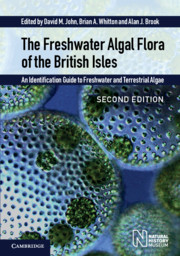 The Freshwater Algal Flora of the British Isles
The Freshwater Algal Flora of the British Isles Published online by Cambridge University Press: 12 January 2024
Natural historians first started to look at algae carefully about two centuries ago, but no doubt many before then had noticed green slimes or algal blooms in their local pond. One of the earliest records for freshwater algae in the British Isles comes from Scotland. The twelfth century abbey of Soulseat, near Stranraer in Dumfries and Galloway, was described as ‘monasterium viridis stagnii’, or ‘the Monastery of the Green Stank’, as translated in a Victorian visitor’s guide. Malodorous blooms, almost certainly caused by blue-green algae, frequently affected the Abbey, situated on a peninsula in a small lake; these blooms still persist to this day. As pointed out by Griffiths (1939b), the development of waterblooms could be a warning of impending tragedy. Two early chroniclers of a lake turning red at Finchampstead, Berkshire, forewarned of the untimely death of William Rufus in 1100.
There were a few scattered observations on freshwater algae during the eighteenth century, but mostly these were made on samples of common organisms used as demonstrations for the microscope. A 1777 record by Stephen Robson for Chara hispida (Plate 2E) in Hell Kettles, two well-known ponds in County Durham, is of interest, because this stonewort, which is about the largest alga in the British freshwater flora, still thrives in the same pond. Such old records are important, because they help us to assess the extent to which changes have taken place, but it was a century later before there were many records with sufficient detail to make such comparisons. This brief history of freshwater algal studies in the British Isles looks mostly at the older accounts, because these are the ones which readers are least likely to come across. A few of the more recent are mentioned, but for each one there are many more for which there is no space. Most research in recent decades by phycologists in the British Isles has been floristic or ecological and there are few critical taxonomic studies on freshwater algae other than diatoms and some green algae. Hopefully, someone will one day write a full account of research on British freshwater algae during the past half century, especially the wide range of ecological studies.
The first attempt to bring together existing knowledge was the publication of Dillwyn’s British Confervae between 1802 and 1809, which included freshwater as well as marine algae.
To save this book to your Kindle, first ensure [email protected] is added to your Approved Personal Document E-mail List under your Personal Document Settings on the Manage Your Content and Devices page of your Amazon account. Then enter the ‘name’ part of your Kindle email address below. Find out more about saving to your Kindle.
Note you can select to save to either the @free.kindle.com or @kindle.com variations. ‘@free.kindle.com’ emails are free but can only be saved to your device when it is connected to wi-fi. ‘@kindle.com’ emails can be delivered even when you are not connected to wi-fi, but note that service fees apply.
Find out more about the Kindle Personal Document Service.
To save content items to your account, please confirm that you agree to abide by our usage policies. If this is the first time you use this feature, you will be asked to authorise Cambridge Core to connect with your account. Find out more about saving content to Dropbox.
To save content items to your account, please confirm that you agree to abide by our usage policies. If this is the first time you use this feature, you will be asked to authorise Cambridge Core to connect with your account. Find out more about saving content to Google Drive.